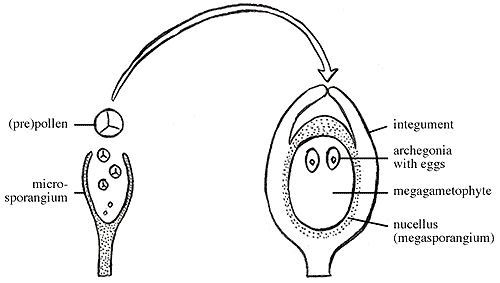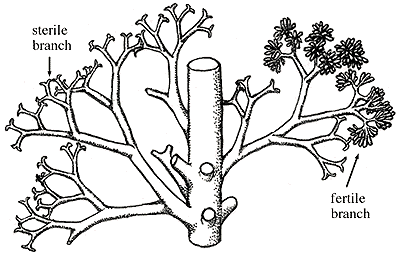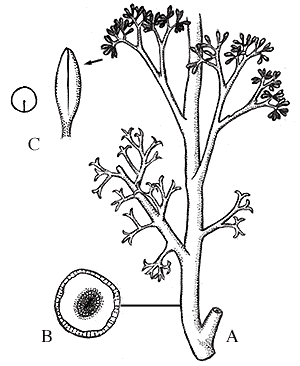![[Laboratory VII - The Origin of Seed Plants]](OspD/OspfontN.jpeg)
![[Laboratory VII - The Origin of Seed Plants]](OspD/OspfontN.jpeg)
When considering seed plants, we talk first about a clade of plants that includes the living cycads, conifers, and flowering plants along with a host of extinct plants including the glossopterids from the Southern Hemisphere and cycadeoids. This clade is united by a large number of synapomorphies, the most important of which include modifications to the mega- and microgametophytes. Commonly, the angiosperms, which are monophyletic, are contrasted with the non-angiosperm seed plants ("gymnosperms" in common usage). However, we prefer not to use the paraphyletic term "gymnosperms"; rather we discuss the discrete clades, such as conifers or cycads.

|
| Figure 7.1: The seed habit is characterized by the megagametophyte retained on the parent plant and enclosed in sporophytic tissue (integument); the seed habit also requires that the microgametophyte be enclosed in a pollen coat and transported to the megagametophyte for development and release of sperm. Early pollen -- sometimes called "prepollen" -- retained the plesiomorphic character of being trilete. Therefore, "pollen" is a functional, not morphological, term.
|
Seed plants also have important morphological and life history modifications that make them distinct from most free-sporing plants (contrast with the arborescent lycopsids that you have already studied). The endosporic megagametophyte develops from a single functional megaspore, which is retained on and nourished by the parent sporophyte. This structure is partially or completely enclosed in sporophytic tissue -- the integument -- to form the ovule. Since the megagametophyte is retained on the parent sporophyte, the microgametophyte must be transferred to the ovule. This is a new feature and contrasts with most free-sporing plants in which sperm, rather than the whole microgametophyte, move to the archegonia. Therefore, in seed plants, the microgametophyte is reduced to only a few cells and transported within a protective sporopollenin shell -- pollen.
The life history modifications entailed by the new morphology also opened ecological doors for the seed plants. First, both micro- and megagametophytes are protected from the cold cruel world by structures produced by the sporophyte: sporopollenin pollen coat for the microgametophyte and integument for the megagametophyte. Since the whole microgametophyte travels to the megagametophyte, sperm cells no longer require environmental water through which to swim. Consequently, seed plants can reproduce in environments where water is less abundant. Although many land plant lineages have evolved members whose sporophytes can tolerate drought, free-sporing plants are limited in distribution by the requirement of environmental water for reproduction. Not only can seed plants colonize new places on the landscape, they can also reproduce at different times (e.g., dry seasons) than their free-sporing cousins. Second, the transfer of pollen to ovule invents a new ecological process -- pollination -- that has provided great fodder for evolution, especially among flowering plants and their animal partners.
To understand the origin of the seed habit, we must first return to the euphyllophyte clade, that diverged from the lycopsids early in vascular plant history.
Psilophyton. The most basal member of the Euphyllophyte clade is Psilophyton (VG 1:1). This genus includes a relatively large number of species for an early plant (perhaps a dozen described species) and substantial morphological variety. Psilophyton ranges from the late Early to Late Devonian, although some questionable earlier representatives have been proposed but not generally accepted. Psilophyton is characterized by a main axis that branches pseudomonopodially rather than dichotomously (Figure 7.2), although branching is generally very irregular. Axes may branch five or six times before terminating in clusters of sporangia that dehisced by a longitudinal slit; Psilophyton was homosporous. Anatomy is reported from only a few specimens. However, these have a large centrarch to mesarch protostele. Psilophyton could reach about 60 cm or more in height.

|
Figure 7.2: Psilophyton dawsonii. This is one of the most well-known members of the genus and happens to be one of those that lacks spines on the axes. (A) Reconstruction of sterile and fertile axes. Note irregular branching pattern. (B) Centrarch protostele with protoxylem black and metaxylem drawn as individual cells. Note differentiated epidermis. (C) Elongated sporangia (polar and equatorial views) with longitudinal dehiscence. |
Some species of Psilophyton have abundant spines of various shapes and sizes on their stems; others are naked. Branching -- style, phyllotaxy, and number -- can be very irregular within a single plant, population of plants, or between species. Some researchers propose that this wide range of morphological variation is an essential feature of the early history of a new lineage. In more conventional terms, the general and variable morphology of Psilophyton may offer essential raw material for the evolution of many different euphyllophyte morphologies. You have already studied two such lineages, the ferns and sphenopsids. Can you develop an hypothesis of morphological transformation from a Psilophyton-like ancestor to these descendent lineages?
Pertica. Another early Euphyllophyte is Pertica (VG 1:2). It is similar in overall morphology to Psilophyton but may reach 1-3 m in height. Branching in Pertica is also more regular with secondary branches emerging in pairs or nearly whorls (Figure 7.3), with distinct internodes. Subsequent branch orders may be dichotomous or pseudomonopodial (or somewhere in between). Branches are covered in fine enations or hairs. Branches may terminate in clusters of many elongate homosporous sporangia.

|
| Figure 7.3: Pertica.
|
If we consider a morphological transition from plants like Psilophyton to Pertica-grade species, we note that branching has become somewhat more regular and size has increased. Watch how this pattern continues in several lineages of progymnosperms that we consider next. Along with an increase in overall size came increased potential reproduction. Where Psilophyton carried one to a few sporangia per axis terminus, Pertica produced clusters of many sporangia. Increased size also allowed more branching and thus more termini per plant. This suggests greater reproductive capacity in Pertica compared to Psilophyton.
![[Title Page]](OspD/Ospbutt.jpeg) |
![[Glossary]](../VPLimg/Glossbutt.jpeg) |
![[Range Chart]](../VPLimg/Rangebutt.jpeg) |
![[Geologic Time Scale]](../VPLimg/timesbutt.jpeg) |
![[Next Page]](../VPLimg/Forward.jpeg) |

